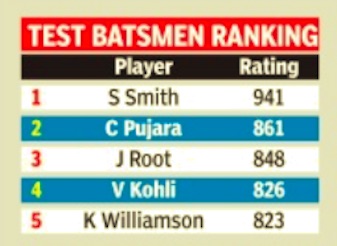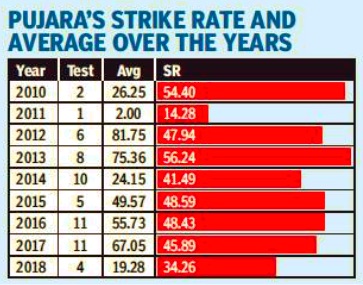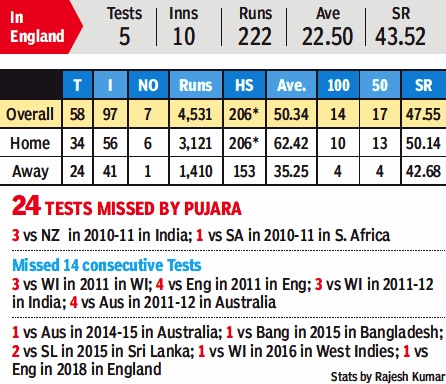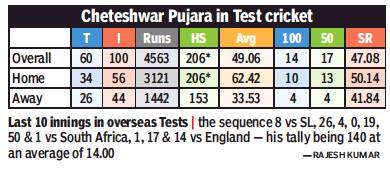Cheteshwar Pujara
This is a collection of articles archived for the excellence of their content. |
Contents |
Career highlights
2017
March: world No.2
Pujara jumps to career-best No. 2 spot, Mar 22, 2017: The Times of India

Indian players continued to rule the International Cricket Council's (ICC) Test rankings as Ranchi double-centurion Cheteshwar Pujara gained four spots to a career-best No.2 spot. Pujara replaced New Zealand captain Kane Williamson to take the second spot.
2018
2018: Batting outside sub-continent slows down
Partha Bhaduri, July 25, 2018: The Times of India

From: Partha Bhaduri, July 25, 2018: The Times of India

From: Partha Bhaduri, July 25, 2018: The Times of India

From: August 2, 2018: The Times of India
Why is Pujara, India’s Test batting specialist, under so much pressure to perform? Is he trying too hard to rework his game according to the team management’s requirements? Or are there more fundamental technical problems which have hampered his performance outside the subcontinent?
Most times at the crease, Cheteshwar Pujara looks like he has just teleported in from the past. Lately, though, he has worryingly seemed stuck in a time loop. For those nervously looking at the clock as the first Test against England nears, the batsman’s ordinary run of form this year may seem like a bad omen.
For Pujara, who seems cursed with that common affliction of intelligent batsmen — the tendency to over-think one’s game — everything may seem on the line. Each time he walks out to bat in England, his poor away record will hang over his head like the sword of Damocles. Every time he is dismissed, it will plunge an inch closer and sway mockingly.
This isn’t the way things were supposed to pan out for India’s successor to Rahul Dravid.
To be fair to the Saurashtra cricketer, being a Test specialist in the T20 era is a hard job. For a batsman of such rare defensive skills as the stoic Pujara, it is easy to be misunderstood. With most teams paying scant respect to the virtues of patience even in longform cricket, being forever hauled up for a ‘lack of intent’ seems to come with the territory. Then there are the long periods out of the game as the multi-format stars ply their trade away from Tests. Game time is scarce, and so is quality bowling at the first-class level. Coming into form takes longer.
It’s easier to be lulled into a false sense of complacency against ordinary attacks. It’s only when the Test begins that Pujara may find he is half a second behind in judging that speedy incoming delivery. It is then that he may find the gnawing fear of getting bogged down welling up all over again. In such circumstances, honing the mind is the first step.
That last step is difficult but hardly impossible for established batsmen with established patterns of play.
For Pujara, it may be time to unleash a newer, refined, less cautious but more calculated version of himself. As things stand, he is far from being the complete, all-weather Test specialist he started out with the promise of being.
At first glance, there is no crisis. He was on a roll in 2016 and 2017, scoring 1976 runs from 22 Tests. There are no two ways about it: Pujara is among the best of his generation in India or Sri Lanka, where the slower, lower pitches allow him more time to get to the pitch of the spinning ball and use that bottom hand to nudge, cut, drive, flick or prise out the gaps. Of his 14 Test hundreds, 10 have come at home, where he averages an outstanding 62.42. It almost seems to follow that he has three Test tons in Lanka too.
But there’s the rub: that leaves just one Test century outside Asia, the 153 in Johannesburg in late 2013. So it’s the 24 away Tests that hide the story of Pujara’s inadequacies. In 17 of those Tests — specifically, those against Australia, England, New Zealand and South Africa — he averages just 27.09, a steep fall from his career average of 50.34. His strike rate falls to 40.25. Against these teams away from home, he has repeatedly got starts and squandered them. This is not to question his basic competence against stronger teams, of course, since at home against these same four teams he averages 61.70 and has eight hundreds from 27 Tests.
It could be that outside familiar subcontinental conditions, Pujara’s game needs fine-tuning. That much has been apparent since his first real dip in form at the international level in 2014 as India performed woefully overseas. It may be time for some reinvention; time to add another dimension to his game.
In England last time around, with all the spotlight on Virat Kohli’s struggles, Pujara averaged just 22.20, the worst-ever average by an Indian No. 3 batsman against England in England. That 2014 series also included a 117-ball 28 at Lord’s in which his strike rate was just 23.93, his worst strike rate in an innings of 25-plus. Interestingly, what troubled him was seam, more than swing.
For someone who likes heavy runs going into a big tour, Pujara has been experiencing somewhat of a drought lately. He averaged just 14.33 from 12 innings for Yorkshire, including taking 70 minutes to get off the mark against Surrey. His Test average this year is below 20, and strike rate below 36. Having scored 88.59% of his runs at No. 3, in his last 2 Test innings he has found himself batting at No. 4. Add to that dodgy knees, a dubious run-out reputation and a few occasions in which he has been dropped in the recent past.
In an era of grandstanding with the bat, Pujara’s staying power at the crease is at the core of India’s Test success away from home. But how much is too much? Right now, he seems stuck between two worlds, caught in two minds on whether to enforce the pace or be dictated by proceedings. It may well be that the team management planted the seeds of doubt, as Pujara himself has hinted, but good batsmen are known to defy the odds and deliver.
Pujara has parked himself in England well in advance, and been picking Joe Root’s brains too. Now he must look within and rediscover his strengths. If he can reprise some of that innate old-world resilience, everyone’s favourite batting anachronism will have done his duty.
2018: after 108 innings
December 7, 2018: The Times of India

From: December 7, 2018: The Times of India
See graphic:
Pujara vis-à-vis Dravid, after 108 innings
India's first innings hero Cheteshwar Pujara on Thursday conceded that the top-order should have batted better on day one of the first Test against Australia.
Pujara's 16th Test hundred and first in Australia helped India recover to 250-9 at stumps, after they had been reduced to 127-6 at one stage.
"We should have batted better but they also bowled well in the first two sessions. I knew that I had to stay patient and wait for the loose balls. The way they bowled, they bowled in the right areas. I also felt that our top order should have batted better but they will learn from the mistakes," he said on Thursday.
"Hopefully we will bat well in the second innings. As far as my innings is concerned, I had prepared well and overall I have the experience of first-class and Test cricket and that came in handy today," he said.
Pujara put on vital partnerships with R Ashwin and Ishant Sharma in the end, as the Australian pacers tired. He opened up and played a few more shots to take India to what the batsman ascertained to be a competitive total.
He added that the wicket wasn't as easy to bat on, and that he needed to take a lot of time to play his shots, which again reflected poorly on how the Indian top-order batted on Thursday.
"It has to be different because when you are batting with the tail, you never know how long can they bat. You have to take your chances but you can't do the same when you are batting with a (top order) batsman. When you are just 1 or 2 down, you can't play the same shots.
"Also, the difference is, I had batted for two sessions and I knew what the pace and bounce of the pitch was. I was set, so I could play my shots. I was a bit disappointed but I had to take that single because only last two balls were left and I wanted to be on strike. I took the chance but Pat Cummins fielded brilliantly," he said of run out on what turned out to be the final ball of the day.
Pujara feels 250 is a decent first innings total, considering the conditions.
"I would say it is a decent total because there is enough turn. Ashwin will also come into play. It is not an easy wicket to bat on. Sometimes when you are seeing it on TV, it doesn't look like it is doing a lot. But when I batted in the first and second sessions, I felt it wasn't easy to bat on and with our fast bowlers, I will share my experience of what line and length to bowl on this pitch.
"It is the grass. The odd ball is skidding on and the odd ball is holding a bit more from the grass. I would say it is kind of a two pace and it is not easy to bat."
Pujara is not known for hitting sixes but it is something he prepared for ahead of the series.
"To be honest, when I was preparing back home, I was working on a few shots and that was one of them. I wasn't surprised that I hit it for a six because I had worked on it back home. I had to obviously bat for two sessions to realise that these are the shots I could play and there were some shots which I had to avoid," he said.
Test cricket
As in 2018, Aug

From: August 19, 2018: The Times of India
See graphic:
Cheteshwar Pujara in Test cricket, As in on Aug 18, 2018